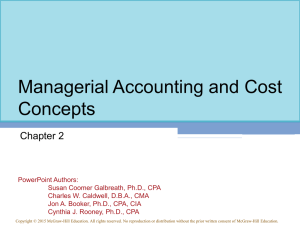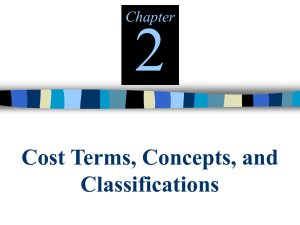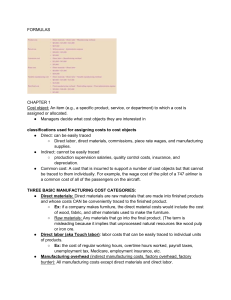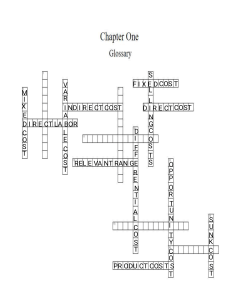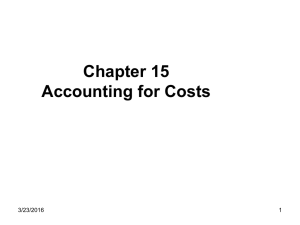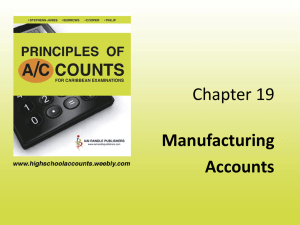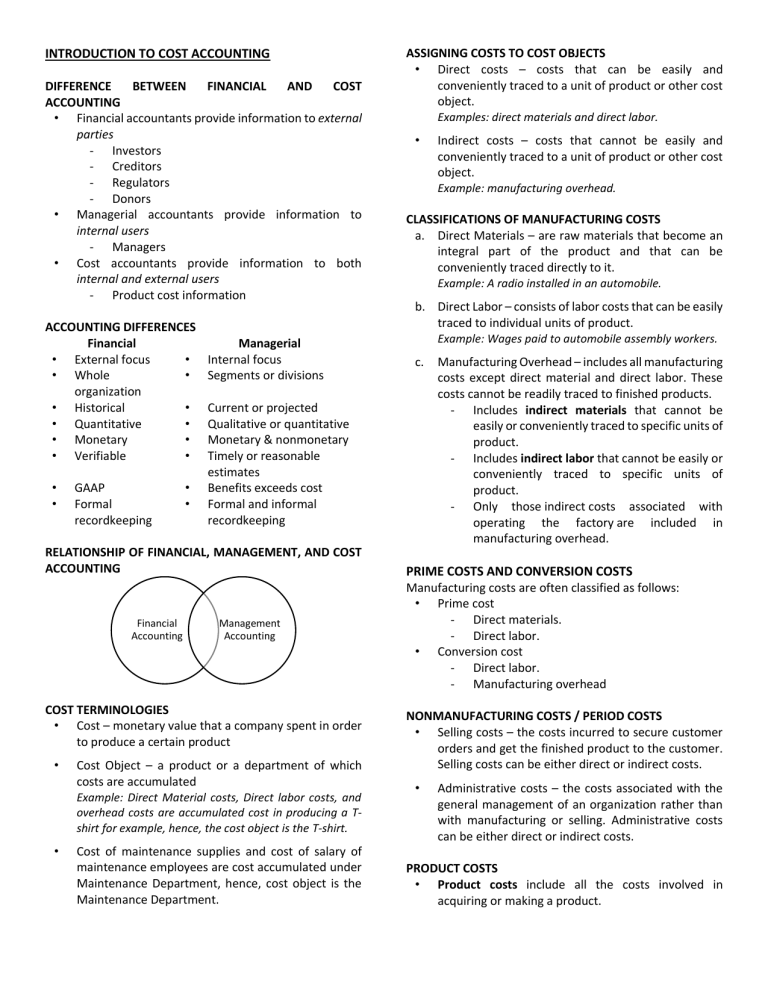
INTRODUCTION TO COST ACCOUNTING DIFFERENCE BETWEEN FINANCIAL AND COST ACCOUNTING • Financial accountants provide information to external parties - Investors - Creditors - Regulators - Donors • Managerial accountants provide information to internal users - Managers • Cost accountants provide information to both internal and external users - Product cost information ACCOUNTING DIFFERENCES Financial • External focus • • Whole • organization • Historical • • Quantitative • • Monetary • • Verifiable • • • GAAP Formal recordkeeping • • Managerial Internal focus Segments or divisions Management Accounting COST TERMINOLOGIES • Cost – monetary value that a company spent in order to produce a certain product • Cost Object – a product or a department of which costs are accumulated Example: Direct Material costs, Direct labor costs, and overhead costs are accumulated cost in producing a Tshirt for example, hence, the cost object is the T-shirt. • Examples: direct materials and direct labor. • Cost of maintenance supplies and cost of salary of maintenance employees are cost accumulated under Maintenance Department, hence, cost object is the Maintenance Department. Indirect costs – costs that cannot be easily and conveniently traced to a unit of product or other cost object. Example: manufacturing overhead. CLASSIFICATIONS OF MANUFACTURING COSTS a. Direct Materials – are raw materials that become an integral part of the product and that can be conveniently traced directly to it. Example: A radio installed in an automobile. b. Direct Labor – consists of labor costs that can be easily traced to individual units of product. Example: Wages paid to automobile assembly workers. c. Current or projected Qualitative or quantitative Monetary & nonmonetary Timely or reasonable estimates Benefits exceeds cost Formal and informal recordkeeping RELATIONSHIP OF FINANCIAL, MANAGEMENT, AND COST ACCOUNTING Financial Accounting ASSIGNING COSTS TO COST OBJECTS • Direct costs – costs that can be easily and conveniently traced to a unit of product or other cost object. Manufacturing Overhead – includes all manufacturing costs except direct material and direct labor. These costs cannot be readily traced to finished products. - Includes indirect materials that cannot be easily or conveniently traced to specific units of product. - Includes indirect labor that cannot be easily or conveniently traced to specific units of product. - Only those indirect costs associated with operating the factory are included in manufacturing overhead. PRIME COSTS AND CONVERSION COSTS Manufacturing costs are often classified as follows: • Prime cost - Direct materials. - Direct labor. • Conversion cost - Direct labor. - Manufacturing overhead NONMANUFACTURING COSTS / PERIOD COSTS • Selling costs – the costs incurred to secure customer orders and get the finished product to the customer. Selling costs can be either direct or indirect costs. • Administrative costs – the costs associated with the general management of an organization rather than with manufacturing or selling. Administrative costs can be either direct or indirect costs. PRODUCT COSTS • Product costs include all the costs involved in acquiring or making a product. • Product costs “attach” to a unit of product as it is purchased or manufactured, and they stay attached to each unit of product as long as it remains in inventory awaiting sale. MANUFACTURING PRODUCT COSTS • Raw materials include any materials that go into the final product. • • Work in process consists of units of product that are only partially complete and will require further work before they are ready for sale to the customer. Finished goods consist of completed units of product that have not yet been sold to customers. TRANSFER OF PRODUCT COSTS Raw Materials Work in Process Finished Goods Cost of Goods Sold • When direct materials are used in production, their costs are transferred from Raw Materials to Work in Process. • Direct labor and manufacturing overhead costs are added to Work in Process to convert direct materials into finished goods. • Once units of product are completed, their costs are transferred from Work in Process to Finished Goods. • When a manufacturer sells its finished goods to customers, the costs are transferred from Finished Goods to Cost of Goods Sold. COST CLASSIFICATIONS FOR PREPARING FINANCIAL STATEMENTS • Product costs include direct materials, direct labor, and manufacturing overhead. • Period costs include administrative costs. all selling costs • The most common classifications are: - Variable costs. - Fixed costs. - Mixed costs. VARIABLE COST • A variable cost varies, in total, in direct proportion to changes in the level of activity. • A variable cost per unit is constant. COST DRIVER • A cost driver is a measure of what causes the incurrence of a variable cost. - Units produced. - Machine hours. - Miles driven. - Labor hours. FIXED COST • A fixed cost is a cost that remains constant, in total, regardless of changes in the level of the activity. • If expressed on a per unit basis, the average fixed cost per unit varies inversely with changes in activity. • Types of Fixed Costs - Committed – long term, cannot be significantly reduced in the short term. - Discretionary – may be altered in the short term by current managerial decisions. THE LINEARITY ASSUMPTION AND THE RELEVANT RANGE • The relevant range of activity pertains to fixed cost as well as variable costs. For example, assume office space is available at a rental rate of $30,000 per year in increments of 1,000 square feet. • Fixed costs would increase in a step fashion at a rate of $30,000 for each additional 1,000 square feet. • Relevant Range: Graphic and The relevant range of activity for a fixed cost is the range of activity over which the graph of the cost is flat. COMPARISON OF COST CLASSIFICATIONS FOR PREDICTING COST BEHAVIOR Cost In total Per unit Fixed Increases/Decreases Constant Variable Constant Increases/Decreases COST CLASSIFICATIONS FOR PREDICTING COST BEHAVIOR • Cost behavior refers to how a cost will react to changes in the level of activity. MIXED COSTS • A mixed cost contains both variable and fixed elements. Consider the example of utility cost. • These costs are not usually found in accounting records but must be explicitly considered in every decision. • For students: What is the opportunity cost you incur by attending class? THE TRADITIONAL AND CONTRIBUTION FORMATS • The total mixed cost line can be expressed as an equation: Y = a + bX Where: Y = The total mixed cost a = The total fixed cost (the vertical intercept of the line) b = The variable cost per unit of activity (the slope of the line) X = The level of activity Example If your fixed monthly utility charge is $40, your variable cost is $0.03 per kilowatt hour, and your monthly activity level is 2,000 kilowatt hours, what is the amount of your utility bill? Y = a + bX Y = $40 + ($0.03 × 2,000) Y = $100 COST CLASSIFICATIONS FOR DECISION MAKING • Decisions involve choosing between alternatives. The goal of making decisions is to identify those costs that are either relevant or irrelevant to the decision. • It is important to understand the terms differential cost and revenue, sunk cost, and opportunity cost. DIFFERENTIAL COSTS • Differential cost (or incremental cost) is the difference in cost between any two alternatives. • A difference in revenue between two alternatives is called differential revenue. • Both are always relevant to decisions. • Differential costs can be either fixed or variable. SUNK COSTS • Sunk costs have already been incurred and cannot be changed by any decision made now or in the future. • These costs should be ignored when making decisions. OPPORTUNITY COST • Opportunity cost is the potential benefit that is given up when one alternative is selected over another. • • Traditional format Used primarily for external reporting Contribution format Used primarily by management USES OF THE CONTRIBUTION FORMAT The contribution format income statement is used as an internal planning and decision-making tool. We will use this approach for: 1. Cost-volume-profit analysis (Chapter 6). 2. Segmented reporting of profit data (Chapter 7). 3. Budgeting (Chapter 8). 4. Special decisions such as pricing and make-or-buy analysis (Chapter 11).
